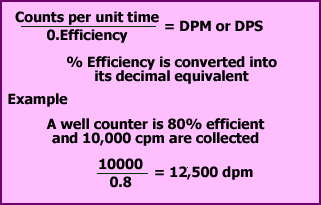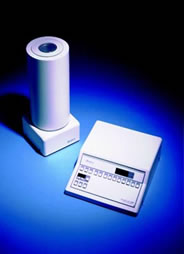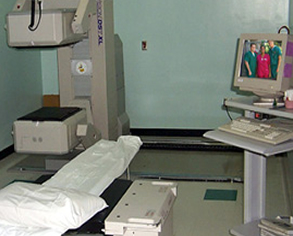Radiation Units And Its Application
-
Units of measurements, but first let's look at the prefixes associated with the different types of units
 |
Tera (T) = 10 12
Giga (G) = 109
Mega (M) = 10 6
kilo (k) = 103
hecto (h) = 102
deca (da) = 101
deci (di) = 10-1
centi (c) = 10-2
milli (m) = 10-3
micro (µ) = 10-6
nano (n) = 10-9
pico (p) = 10-12
femto (f) = 10-15
atto (a) = 10-18 |
 |
You must be able to move between these values as if it's second nature to you.
Point of interest: When working with Ci we tend to use milli and micro and when working with Bq we tend to use Mega and Giga.
| Example 1 nanos = 10-15 Mega |
Example 1 gigas = 1021 pico? |
| 2.3 M = _______ f |
1.5 x 1025 = _______ k |
Remember - when you are working with exponents and applying division subtract and when multiplying exponents you add!

Next we need to look at how radiation is measured. There are different types of units that need to be considered. They are noted below in the table. As a student you must be able to define each unit, understand both the English and SI values, and be able to convert between English and SI.
English Unit |
SI Unit |
| Roentgen (R) = 2.58 * 10-4 C/kg (coulomb per kilogram) |
Coulomb/kg (C/kg) |
| Radiation Absorbed Dose (RAD) = 100 erg/gm |
Gray (Gy) = 100 RAD |
| Relative biological effectiveness (RBE)=Dose in rad to produce same effect with x or gamma ray/
Dose in rad to produce same effect with radiation under investigation |
Becquerel (Bq) = 1 dps |
| Roentgen equivalent man (REM) = RBE*RAD |
Sievert (Sv) = 100 REM |
curie (Ci) = 2.2 * 1012 dpm
Ci =3.7*1010 dps |
Becquerel (Bq) = 1 dps |
-
Here are some examples on how to work with these different radiation units
- Moving the decimal around with prefixes
- If you have 30.3 mCi of radioactive material what is its Ci value?
- If you have 1.5 x 10-3Ci what is its mCi value?
- Convert R to C/kg to R (this one is not as important)
- 1 R = 2.58 * 10-4 C/kg [As noted from the formula above]
- 1 C/kg = 3.876 * 103 R [To convert back invert the previous value]
Convert RAD to Gray to RAD (think 102)
- RAD = 100 erg/gm
- Gy = 100 RAD
- 1 RAD = 1.0 x 10-2 Gy
- How many mRAD = 50 Gy? Answer
- Calculate: 134.4 mGy = ________ RAD or _______mRAD
- Convert REM to Sv
to REM (think 102)
- In general terms remember what a REM is equal to REM = RBE * RAD
- Sv = 100 REM
- 1 REM = 10-2Sv
- Calculate: 66.1 REM = _______ mSv or _______Sv
Convert 2 mCi to Bq (think 37 or 3.7 x 1010 dps = 1 Ci)
2 x 3.7 x 107 = 7.4 x 107 or 74 MBq
Calculate: 120 MBq = ______ mCi
Calculate: 250 mCi = ______GBq
Remember to think 37
More information on units of measurement in radiation
- An indicator of the intensity of the radiation
- Can only be used for x or gamma rays
- Instruments detection include: Ionization chamber and GM meters and dose calibrators
- 1000mr = 1 R (remember that 1k = 1000)
- Ionization radiation occurring in Photoelectric or Compton range
- 2.58 * 10-4 coulombs/kg of air
- 100 ergs
- Used to measure the amount of dose administered
- Amount of radiation absorbed per gram of absorbed material
- Amount of actual radiation absorbed by an organ or the whole body
- 100 RAD = 1 Gray
- Is a ratio comparing the biological effect of radiation
- Radiation absorbed dose of radiation under investigation divided by
radiation absorbed dose
of gamma or x-ray
- Relates alpha or beta to gamma and x-ray
- Example: 20 gamma rays create the damage of 1 alpha
- Dose in RAD * Dose in RBE
- Approximately equivalent to rad
- Amount of radiation you are receiving recorded by your badges
- Amount of dose being absorbed by the body
- Appears on a radiation report indicating the amount of radiation received by a radiation worker
- RBE, RAD, REM are all relatively equivalent to one another
- 100 REM = 1 Sievert
Disintegrations Per Minute (dpm)
Remember that 1 Bq is equal to 1 disintegration per second (dsp). For every disintegration that is measured a gamma ray is detected. Likewise, if a group of atoms decayed and emit 1000 gamma rays in a second then the amount recorded would be 1000 dps.
Usually, the two units used when detecting radiation in this manner is either in dps or dpm. Note the value of these units as they relate to a Ci.
- 1 Ci = 3.7 * 1010 dps
or
- 1 mCi = 3.7 x 107 dps or
- 1 μCi = 3.7 x 104 dps
- 1 Ci = 2.2 * 1012 dpm
- 1 mCi = 2.2 x 109
- 1 μCi = 2.2 x 106
Here are two ways radiation is recorded. Prior to injecting a patient a dose calibrator is used to measure the amount of activity (radiation) that will be injected into a patient. This unit usually used to record the patient dose is usually in mCi or μCi. Once the activity is injected into a patient a gamma camera or scintillation detector is used to measure the distribution of the radioactive compound. This device records counts over time, not disintegrations. Any idea as to why? The images below there are the two types of instruments under discussion. On the left is a dose calibrator and on the right is a two-headed gamma camera.
As mentioned, a dose calibrator measures the radioactive dose (radiopharmaceutical) being administered to the patient. As an example, a syringe is placed into the the dose calibrator and measures 25 mCi of 99mTcMDP. What is this equivalent to in Bq? Answer After the patient is injected the activity being emitted from the patient is acquired on the gamma camera. The gamma camera detects the gamma rays, either in total counts. While we are recording the amount of counts the image displays distribution of MDP within the skeletal system |
 |
An Important difference between dps/dpm and cps/cpm
Uptake probes, well counters, and gamma cameras actually record counts in counts [not disintegration] per minute or seconds (cpm or cps). If any of these instruments were able to count 100% of all the radiation being emitted, then we could say it records in dps/dpm. However, this can never happen because NO system has 100% counting efficiency. Therefore, a technologist must be able to convert cps/cpm to dps/dpm.
The key to determining the total disintegration from total counts is to know the efficiency of your counting system. Follow the example given and example given on converting counts to disintegrations.





